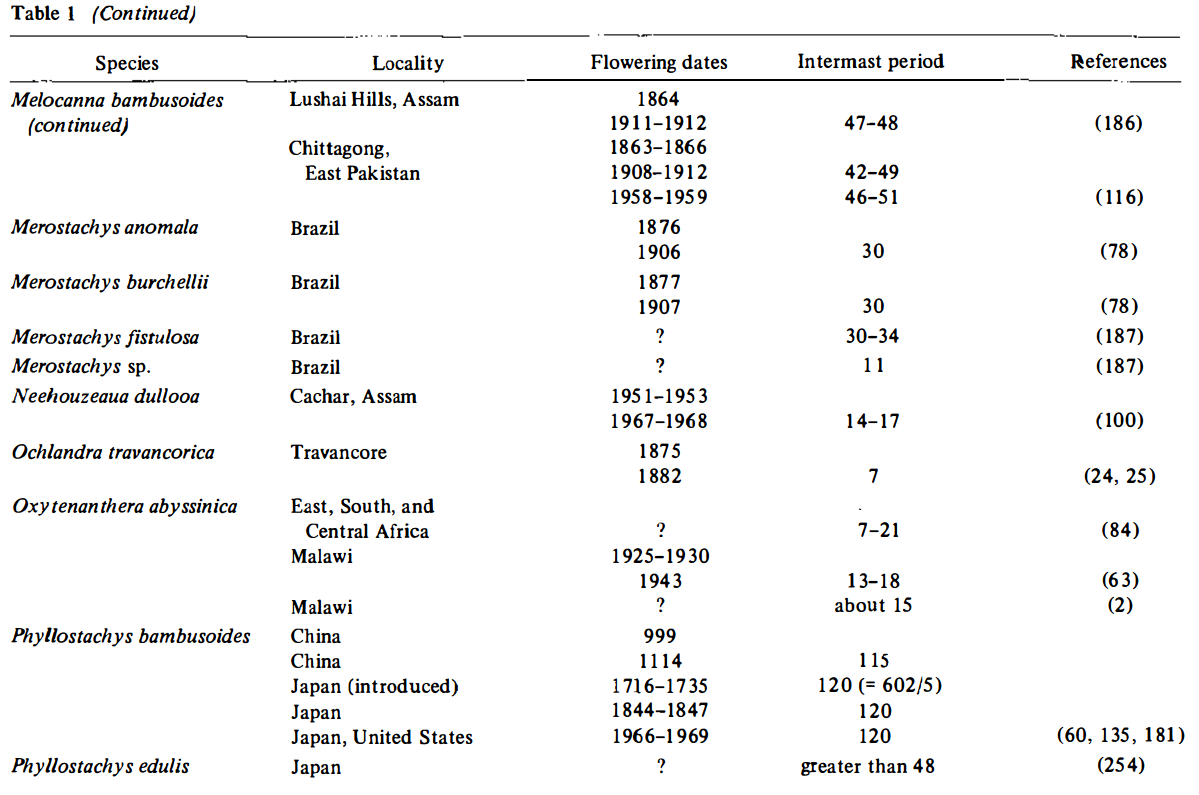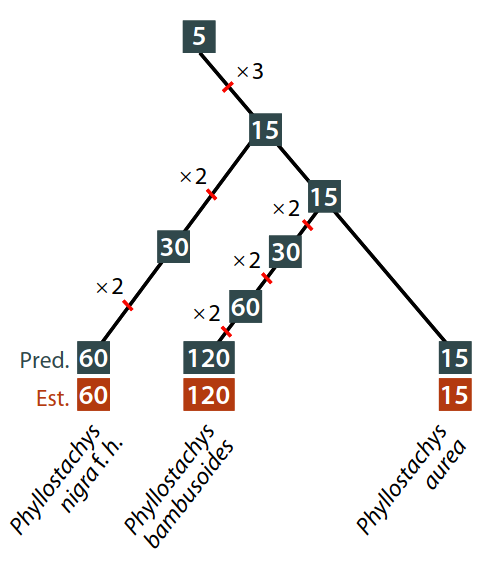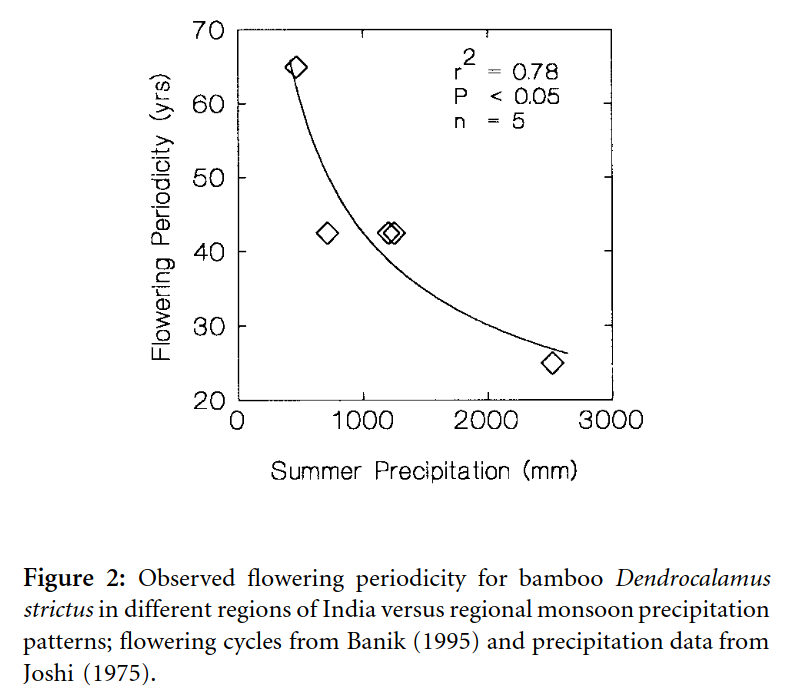Do bamboos set themselves on fire?
post by Malmesbury (Elmer of Malmesbury) · 2022-09-19T15:34:13.574Z · LW · GW · 14 commentsContents
Bamboo wars: bamboo-made famine Bamboo wars 2: the bamboozling Bamboo wars 3: Judgment Day Summary None 14 comments
Cross-posted from Telescopic Turnip.
As we all know, the best place to have a kung-fu fight is a bamboo forest. There are just so many opportunities to grab pieces of bamboos and manufacture improvised weapons, use them to catapult yourself in the air and other basic techniques any debutant martial artist ought to know. A lesser-known fact is that bamboo-forest fights occur even when the cameras of Hong-Kong filmmakers are not present. They may even happen without the presence of humans at all. The forest itself is the kung-fu fight.
It's often argued that humans are the worst species on Earth, because of our limitless potential for violence and mutual destruction. If that's the case, bamboos are second. Bamboos are sick. The evolution of bamboos is the result of multiple layers of shear brutality, with two imbricated levels of war, culminating in an apocalypse of combustive annihilation. At least, according to some hypotheses.
Bamboo wars: bamboo-made famine
Recommended soundtrack for this part
If you enter a bamboo forest and wait for a long time, you may have the chance to witness their strange mating ritual. And by "a long time", I mean you'll probably have to wait for decades before you see anything happen at all. But eventually, all the bamboos in the forest will start to produce an absolutely massive amount of seeds, all at the same time.

And then they all die. The swarm of seeds will give birth to a new generation of bamboos, and it will take another few decades before you see any flower again. Based on historical texts relating the event, we can estimate that some species like Phyllostachis bambusoides flower only once every 120 years:

That's really puzzling. Wouldn't a species with a shorter cycle, hence a higher growth rate, take over the forest exponentially fast? Why would bamboos wait for so long before blooming?
The extension of flowering cycles to ridiculous lengths probably happened in two stages. The first stage is about bamboos fighting their predators, the second is about bamboos fighting each other. Then, there is a speculative bonus third stage about bamboos destroying every form of life that has the misfortune to be nearby.
Imagine you're a bamboo. You just released a batch a freshly-baked seeds, only to discover that all the animals in the forest are eating them. You could respond by making more seeds, but then the population of predators would just become bigger and still eat everything. That's when it becomes useful to increase the gap between two flowering events. Instead of producing n seeds every year, you produce 3n seeds every three years. This way, all the predators with a lifespan below 3 years will starve between two flowerings, so their population remains low. When the day comes to release your seeds, there are so many of them that the small predator population can only eat a little part of it, until they are simply not hungry any more. And then, they should leave enough seeds to start a new generation of bamboos. The predators might reproduce like crazy after the feast, but it's ok: your descendant will take so long to flower that most of their descendants will have died of starvation by then.
(Now you can stop imagining you're a bamboo.)
This destructive but effective phenomenon is known as "predator satiation". And when we say satiation, we are not kidding. Here we love beautiful stories of cute little animals, so here are some from the archives: "The seed grew in clusters and resembled oats, and all the animals and fowls got rolling fat from eating this seed" (Hughes 1951[1]), "I have known of village cattle gorging themselves on the fruit to such an extent as to die subsequently from the effects of overeating" (Thom 1935[1]) and so on.
Alright, we have now pwned the enemies, making them so fat that they go rolling down the hill and we never see them again. Mission accomplished. Have we finally pacified the bamboo forest? Not so fast. This only marks the beginning of the next level of conflict escalation.
Bamboo wars 2: the bamboozling
If all the individuals in the forest are releasing their seeds at the same time, the obvious strategy is to release more seeds than everyone else. There's a way to do that: a new mutant can adopt an even longer flowering cycle, so it can hold back resources and produce even more seeds. Of course, it still needs cross-pollination, so the bamboo should keep flowering at the same time as everyone else, so the new cycle should be a multiple of the current one. Under the right circumstances, making more seeds can offset the cost of skipping cycles. Here is a calculation (slightly modified from Veller 2015): say each individual bamboo produces m seeds per cycle, and each seed has a probability p of growing into a fully-fledged bamboo. The growth rate over 2 cycles is:
Now imagine a new mutant bamboo who flowers only half of the cycles, but produces s times as many seeds:
The new mutant will grow faster if s > mp, which is likely to happen if growth is slow (m is small) or the survival rate is small (p is small), which sounds pretty realistic for bamboo flowering in an already crowded forest. If you consider how bamboos darken the sky with swarms of little seeds during masting, p must be very small indeed. So our brave mutant eventually replaces all the other bamboos, and now everybody flowers every 2n years. At this point, it's very unfavourable to come back to the original n years, so no return is possible.
Once the slower bamboo strain takes over the forest, the road is free for another mutant with an even slower flowering cycle to take over. This goes on until the flowering cycle is so slow that it's ridiculous and you hit diminishing returns.

Really makes you meditate on Moloch.
Bamboo wars 3: Judgment Day
Recommended soundtrack for that part
Not everybody is satisfied with this explanation. For example, if there are so many species of bamboos with different cycles, what prevents predators from just moving from one to another depending on the year? Keeley and Bond have another explanation, what they call the Bamboo Fire Cycle. Be prepared, the conflict is about to escalate into a meltdown of fiery bamboo fulmination.
The naive reader might think that bamboos don't like fire very well, as they are themselves made of flammable material. That's forgetting bamboos are semelparous, meaning that after releasing their seeds, they die, leaving only a skeleton of dry, dead wood. This skeleton might as well burn, as the seeds are already gone anyway.
As it turns out, bamboos are exceedingly efficient at repopulating areas devastated by wildfire. Keeley quote another obscure 19th century report: “The jungle fires of March, April and May subsequently swept away the tangled masses of dry stems, and after the rains of 1861, the ground everywhere was covered by millions of seeding bamboos, which soon grew up into slender plants, 2 to 3 feet high, forming dense waving green masses on the ground under the trees.” Even if the emerged part of the plant burns, the bamboo can recover from the rhizomes hidden under the ground. This is confirmed by Keeley's key witness, M. Gadgil: “Indeed, bamboo seedlings will resprout under fire intensities that kill associated tree seedlings (M. Gadgil, personal communication)”. Let's all hope M. Gadgil is a reliable source.
In fact, as there are more and more wildfires, entire portions of the Amazon rainforest destroyed by fire are being replaced by bamboos: “The impact of forest fires resulted in incursion and dominance of bamboo culms over an area of 120,000 ha, changing the forest type of this area to 'bamboo-dominated forest'.” As smoking-gun evidence, absolute madmen Smith & Nelson (2011) went ahead and burned 2,500 m² of Amazonian forest and found that, indeed, the patch was quickly invaded by bamboo[2].
Thus, I don't want to accuse anyone but, cui bono? If forest fires are advantageous to bamboos, then what a coincidence that bamboos are taking years to grow into densely-packed sticks of lightning-rod-shaped dry wood, after making sure the soil is saturated with their seeds? The Fire Cycle hypothesis therefore claims that bamboos are the way they are because they use lightning to set themselves on fire, then burn the entire competing vegetation to the ground, then rapidly invade the cleared fertile ground. Here is Keeley's n=5 evidence:

The scientific community is divided. As Saha and Howe (2000) curtly put it, “We do not find the hypothesis compelling.” Their main concern is that, basically, forest fires are always caused by humans and never by lightning, at least in the regions relevant to the bamboo wars where, whenever there is lightning, there also heavy rains.
To get to the bottom of it, Rayle (2015) dug up some bamboo phytoliths from the soil, and checked for charcoal in the vicinity, which would mean more fire = more bamboo. On one hand, some species were definitely associated with forest fires. On the other hand, there were no traces of fire before a thousand years ago, so all these fires were probably the result of human activity. Therefore, the Fire Cycle is probably not why bamboos are growing so old, or why they are shaped like lightning rods. Bamboos do not set themselves on fire. We do. But, regardless of the cause of the fire, it's still the case that species that can burn everything around them, then quickly invade the cleared land afterwards are at an advantage. As humans cause forest fires, we might effectively be breeding bamboos into war machines. Beware, bamboo maximizers are coming.
Summary
- The niche that bamboos occupy requires them to flower at the same time (to cross-pollinate) but not have their seeds eaten by predators,
- One way to solve the problem is to flower at rare intervals, longer than the lifespan of the predators,
- A mutant can benefit from skipping cycles, to accumulate more resources and produce more seeds at once. This causes the population to escalate to absurdly long cycle length,
- Bamboos are good at invading the space after a forest fire. There might be especially adapted for that, and they might even be adapted to start forest fires,
- This is unlikely to have shaped the evolution of bamboos as we know them, since fires were rare before human activity.
- ^
All quoted by Janzen 1976.
- ^
I kid you not. From the paper: "A 50×50-m burn plot and a nearby 50×50-m control plot were also established in September 1998. (...) Under the early afternoon sun, the plot was ignited at several places to provide a homogeneous ground fire."
14 comments
Comments sorted by top scores.
comment by tgb · 2022-09-19T18:12:25.296Z · LW(p) · GW(p)
Very interesting. Seems like the growth rate equations are off. Since the trees die off after giving off their seeds, population is just (mp)^2 after two generations. In steady state, mp will always have to be about 1, which puts a somewhat high bar on s to make it worth it (can you really double seed production by waiting twice as long?).
And where do the bamboo store all these seed producing resources for so long?
Replies from: Elmer of Malmesbury, Sune↑ comment by Malmesbury (Elmer of Malmesbury) · 2022-09-21T12:38:03.839Z · LW(p) · GW(p)
You're right! Corrected. As where the extra resources are stored, I don't know enough about botanic to tell, but here's what they say in the paper: "First, plants that wait longer to flower may accumulate greater energy resources to invest in producing more seeds, and/or seeds that are better protected (Fenner 1985). (The latter scenario, involving better-protected seeds, seems less applicable to bamboos, whose ancestral fruit type is a caryopsis, i.e. fruits with seeds that are generally less well protected than those of many other flowering plants.) In bamboos, this investment might, for example, take the form of increased shoot production between masts". So, at least from that paper, it doesn't look like there's a clear mechanistic explanation, aside from more bamboo.
↑ comment by Sune · 2022-09-19T19:03:00.633Z · LW(p) · GW(p)
I agree, it should be (mp)^2. But you will just need 1+s>mp for the delay to be an advantage, which in steady state means we just need s to be positive.
Replies from: tgb↑ comment by tgb · 2022-09-19T20:05:29.544Z · LW(p) · GW(p)
That looks right mathematically but seems absurd. Maybe steady state isn’t the right situation to think about this in? It’s weird that the strategy of “never reproduce” would be just as good as the usual, since not reproducing means not dying. Or we need to model the chance that the bamboo dies due to illness/fire/animals prior to getting a chance to reproduce?
Replies from: Elmer of Malmesbury↑ comment by Malmesbury (Elmer of Malmesbury) · 2022-09-21T12:51:12.802Z · LW(p) · GW(p)
Yes, I'm pretty sure there is some diminishing return after some decades (though, apparently, they hit pretty late for bamboos). Now if we stick to the absurd model with no diminishing returns, we can imagine a mutant that almost never reproduces, but when it does, it suddenly covers the entire planet, erasing all the other strains that have been growing exponentially in the meantime. The limit where it doesn't reproduce at all is when a bamboo in a forest appears dead, but will eventually turn the entire universe into copies of itself when comes the Armageddon.
comment by habryka (habryka4) · 2024-01-15T07:56:51.903Z · LW(p) · GW(p)
I really liked this post. It's not world-shattering, but it was a nice clear dive into a specific topic that I like learning about. I would be glad about a LessWrong with more posts like this.
comment by M. Y. Zuo · 2022-09-22T03:32:13.383Z · LW(p) · GW(p)
How exactly does an individual bamboo store 120 years worth of seeds? Unless it's hyper dimensional I don't see how it can contain that much volume.
Replies from: Elmer of Malmesbury↑ comment by Malmesbury (Elmer of Malmesbury) · 2022-09-24T19:21:36.826Z · LW(p) · GW(p)
According to the paper, that would be the same individual making several shoots.
comment by Lone Pine (conor-sullivan) · 2022-09-20T15:28:08.645Z · LW(p) · GW(p)
Were there really no forest fires before humans? Aren't there species of plant whose seeds depend on fire?
Replies from: Elmer of Malmesbury, Measure↑ comment by Malmesbury (Elmer of Malmesbury) · 2022-09-24T19:21:04.611Z · LW(p) · GW(p)
You mean seeds that can only work if there's fire? If you have any example in mind, I'm very interested.
Replies from: mruwnik↑ comment by mruwnik · 2022-10-11T13:19:26.137Z · LW(p) · GW(p)
Check out pyrophytes. Or in general fire ecology, which is quite fascinating. Conifers are common culprits. Sequoia's are a well known example of a plant that pretty much require a fire for their seeds - the cones are thick and often covered in an additional layer for protection, which require high temperatures for them to crack and let the seeds fall out. A lot of plants in Australia, California etc, (i.e. places where you'd expect common fires) tend to have various fire protections or enhancements. Though you can also get them in other places - Scots pine (Pinus Sylvestris) is a temperate species that isn't very competitive (gymnosperms are generally less well off than angiosperms and tend to live in less hospitable places), but has:
- a tall trunk with branches high up
- a very thick lower bark
- fine, flaky bark on the upper portions
- pine cones that open when the weather is nice (i.e. hot and dry)
- very light, wind dispersed seeds
- a tendency to be a pioneer species (i.e. grows on open dirt, after disruptions like fires)
All of the above are useful in the case of a fire - temperate forest fires tend to be in the understory (at least in naturalish European ones, which I'm most familiar with), so the insides and upper branches are protected. At the same time, flakes of bark, thinner than most paper, break off, catch fire and are blown over to light other stuff on fire. The heat opens the cones and disperses the seeds, which can sprout on a nicely cleared area, freshly fertilized with lovely wood ash.
Below is what the flaky stuff looks like

↑ comment by Malmesbury (Elmer of Malmesbury) · 2022-11-04T04:10:22.061Z · LW(p) · GW(p)
I'm only seeing this now, thanks for all the info!
↑ comment by Measure · 2022-09-20T18:55:21.187Z · LW(p) · GW(p)
The point about forest fires is that they were rare enough before humans that they probably didn't apply much selection pressure. Some (most?) conifers have seed cones that can survive fires and reforest burned areas, but their seedlings don't grow as quickly as bamboo.